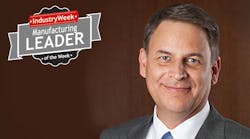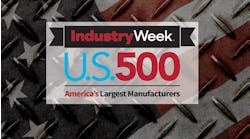NAM's CEO Barnstorms for Manufacturing-Friendly Policies
In the midst of what many consider a manufacturing renaissance, does NAM President and CEO Jay Timmons need to be on a cross-country tour promoting the value of manufacturing? If you don’t think so, consider his experience at the University of Kansas last September.
Addressing an audience of about 1,000 students, Timmons asked how many had set a goal of getting a job in manufacturing. Not a single hand was raised. Timmons then asked the audience members to take out their smartphones.
“Then I said, ‘Which one of you in this room wants to be the person that dreams up, that invents the next great thing that changes the world for the better?’” Timmons recalled. “All of a sudden all these hands went up.”
When IndustryWeek caught up with Timmons, he had just completed the Midwest leg of his State of Manufacturing tour with an address at the City Club of Cleveland. Timmons said his tour was designed to get people more active in meeting with elected officials and developing policies that will grow U.S. manufacturing in a sustainable way. But the tour is also dedicated to changing the perception of manufacturing, particularly among the young.
“Manufacturing today is very cool, very sleek, very technology driven, and it has skill needs like we have never had in the past,” said Timmons. He wants not only young people to hear that message but also their parents, a generation that manufacturing to a large degree skipped. He said manufacturers need to connect with children’s curiosity and love of making things.
“We need to tap into that creative DNA that exists in every single young person and get them to understand what potential is out there for them in the future,” said Timmons.
Timmons lauded the vitality of manufacturing, noting that it accounts for more than $2 trillion of the U.S. economy annually. Since 2009, he noted, manufacturing has regained 855,000 jobs. Add to that 22,000 more manufacturing jobs created in January reported by the U.S. Bureau of Labor Statistics. Moreover, Timmons cited research that each manufacturing job supports three to five additional jobs in other industries.
Timmons reminded his audience, which included local manufacturing executives such as Mike Hilton, CEO of Nordson Corp. (IW 500/447) and Walt Rosebrough, CEO of Steris Corp. (IW 500/450), that Ohio is a manufacturing stronghold. It has 660,000 employed in the sector, and accounts for 18% of the state’s economic output.
With its tradition of providing a pathway to the middle class and its continuing economic clout, Timmons told his audience, manufacturing has a “disproportionate responsibility to keep our economy humming along.”
But along with touting what is good about American manufacturing, Timmons’ tour is intended also to highlight challenges confronting the industry. He complained that manufacturing faces a “disproportionate share" of the burden of government regulations. The current regulatory system is “unnecessarily complex and inefficient,” he claimed.
Small manufacturers face a particular burden from regulations, he noted. He cited a study that regulations cost them an average of $35,000 per employee per year.
Dealing with Climate Change
Timmons cited two particular targets of NAM’s ire – EPA’s proposed regulation of emissions from existing power plants and its proposed rule to lower limits for ground-level ozone.
At the City Club event, Timmons was questioned about NAM’s opposition to the greenhouse gas regulations. “Is the NAM a denier of the facts that we are getting hotter and are there costs of not doing anything like having the kinds of energy programs geared to coal that we had 25 years ago?” an audience member asked.
The debate over climate change “is settled,” Timmons responded. What NAM was calling for, he explained, was regulation of industry that achieved the regulation’s objectives but does so in a way that doesn’t harm the economy or amount to unilateral action. ”We can’t be the only country leading the way,” Timmons said.
Corporate and individual tax rates are also a problem for manufacturers, Timmons told the City Club audience. The U.S. corporate tax rate of 35%, the highest in the world, must be fixed, he said. America’s “outdated tax code” is driving foreign investment away and “driving investors out of our country,” he charged.
Because two-thirds of manufacturers are taxed at the individual rate, any tax increase would raise taxes on all of them. Timmons said President Obama’s “proposed punitive tax increases on investments and small businesses would stifle economic growth.”
Noting that 95% of the world’s customers live outside the United States, Timmons said domestic manufacturers “want to be where they are buying stuff.” He pointed out that Ohio manufacturers trade with more than 200 countries and 90% are small-to medium-sized businesses. He called for trade measures to grant the president trade promotion authority, accelerate free trade agreements and provide long-term reauthorization of the Export-Import Bank.
Increased investment in America’s infrastructure is also needed, Timmons said. Many of the nation’s ports, railways, roads and runways were “built for a bygone era,” he said, and are in “desperate need of repair.” Timmons urged a public-private partnership to fund infrastructure improvements. He pointed to an NAM study that found a sustained investment in infrastructure over 15 years would create 1.3 million jobs initially and return three dollars for every dollar invested.
Timmons reiterated NAM’s call for an “all of the above” energy policy that takes full advantage of domestic energy sources such as shale gas. “If we develop this resource correctly, we can create a million new American jobs over the next 10 to 15 years,” Timmons said.
In that vein, Timmons called for approval of the Keystone XL pipeline. “There really are no more excuses left,” he said. “It is time to act.”
Describing the nation’s immigration system as “broken,” the NAM president called for comprehensive reform. He stressed that immigrants were vital to the nation’s economy and their desire to come to the U.S. reflected the attractiveness of the country as a “beacon of opportunity.” Timmons said manufacturers need access to high-skilled workers and more visas needed to be granted through the H1B visa system until the U.S. education system can meet that demand. Timmons also called for reform of the guest worker program and for improved border security.
Most fundamental to immigration reform, Timmons said, is development of a bipartisan solution that provides a “pathway for citizenship” for undocumented immigrants. He said this was particularly important for those who want to be a “productive part of our economy.”




